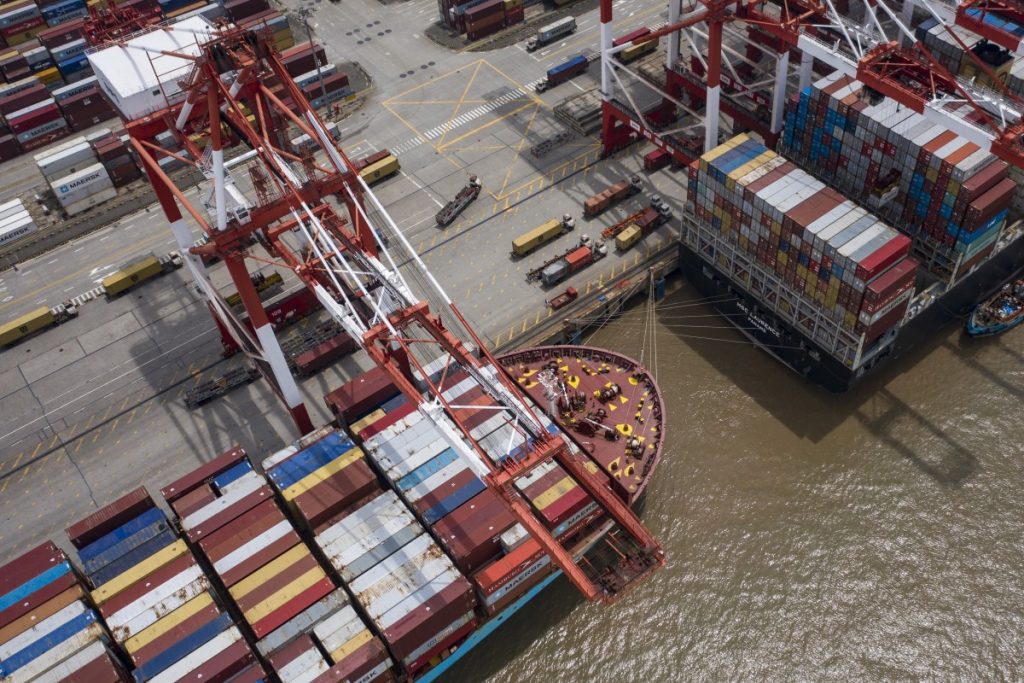
China’s exports surged unexpectedly last month, as the pace of import growth cooled, data released by the country’s customs agency on Saturday showed.
Exports grew by 11.4 per cent last month, compared to a year earlier. This was faster growth than in September, when exports rose by an 18-month high 9.9 per cent. October’s figure was above the 9.2 per cent forecast of a Bloomberg poll of analysts and was again the highest monthly growth rate since March 2019, when exports surged 14.2 per cent.
Imports grew by 4.7 per cent over the same period from a year ago, down from a surprise jump of 13.2 per cent in September. Analysts had forecast growth of 8.6 per cent in October. The previous month had brought an all-time record import haul of US$203 billion, but that cooled to US$178.74 billion in October.
The country’s trade balance stood at US$58.44 billion, up from US$37 billion in September. The 38.1 per cent increase came amid surging exports and a dip in import growth.
A minor slowdown had been telegraphed in multiple data points. In the official manufacturing purchasing managers’ index for last month, factory owners’ expectations of export orders had plateaued after months of surging through the summer.
But those expectations were shattered by the strongest monthly export growth since before the pandemic. Exports to major trading partners, including the United States, European Union and Asean, all grew strongly. Meanwhile shipments of medical goods and electronic goods continue to power the Chinese economy.
In September, the import surge had been partly powered by Chinese companies stuffing their inventories of technological components, particularly integrated circuits, as a means of hedging against any future tech bans. Huawei, for instance, was thought to have front-loaded chip purchases ahead of a US ban on foreign companies selling chips containing American parts to the Chinese giant.
In October, overall imports of integrated circuits were up 15.8 per cent year on year, to US$31.36 billion. But this was still 15 per cent smaller than September’s shopping spree.Despite the escalating trade dispute with Australia, with China issuing unofficial bans on a plethora of Australian goods from wine and timber to barley and coal, bilateral trade actually increased last month.
Chinese exports to Australia rose 16.62 per cent from a year earlier to US$5.35 billion, while imports from Australia rose 6.64 per cent to US$10.11 billion.
Bilateral trade with the United States expanded in October from a year earlier. China’s trade surplus with the US rose 18.74 per cent from a year earlier to US$31.35 billion, in the last month before the American election. This was up from US$30.75 billion in September and was 46.5 per cent higher than when Trump took office in January 2017.
of US farm goods such as soybeans and corn slowed in the fortnight leading up to the poll, with near-daily flash sale reports of sales of more than 100,000 tonnes from the US Department of Agriculture becoming less frequent.
China’s overall imports of soybeans in October surged by 41.67 per cent from a year earlier. In the same month, China’s share of Brazilian soybean exports fell to its lowest level since 2015, suggesting that the bulk of the beans heading to China are American.It remains to be seen whether China will continue to stick to the purchase agreements laid out in the phase one trade deal under a potential Joe Biden presidency. The front runner looks set to maintain the pressure on China, but is also a known advocate of free trade.
Earlier this year, China had enjoyed a trade windfall due to coronavirus lockdowns across the world. China, which was the first major economy to recover from the shutdowns caused by the pandemic, was making the masks, medical goods, home working equipment and electronic goods for which demand surged across the West.
As European economies head back into lockdown, it remains to be seen if this sort of voluminous demand will return.
“I’m not expecting a big additional surge on top of already very strong export growth – households never stopped spending on lockdown goods. [This is] principally because the production side of the equation in the US and Europe will probably continue to gradually recover regardless, eroding China’s supply advantage, and it seems like government income support to households will not be as big this time,” said Thomas Gatley, a China analyst at Gavekal Dragonomics in Beijing.